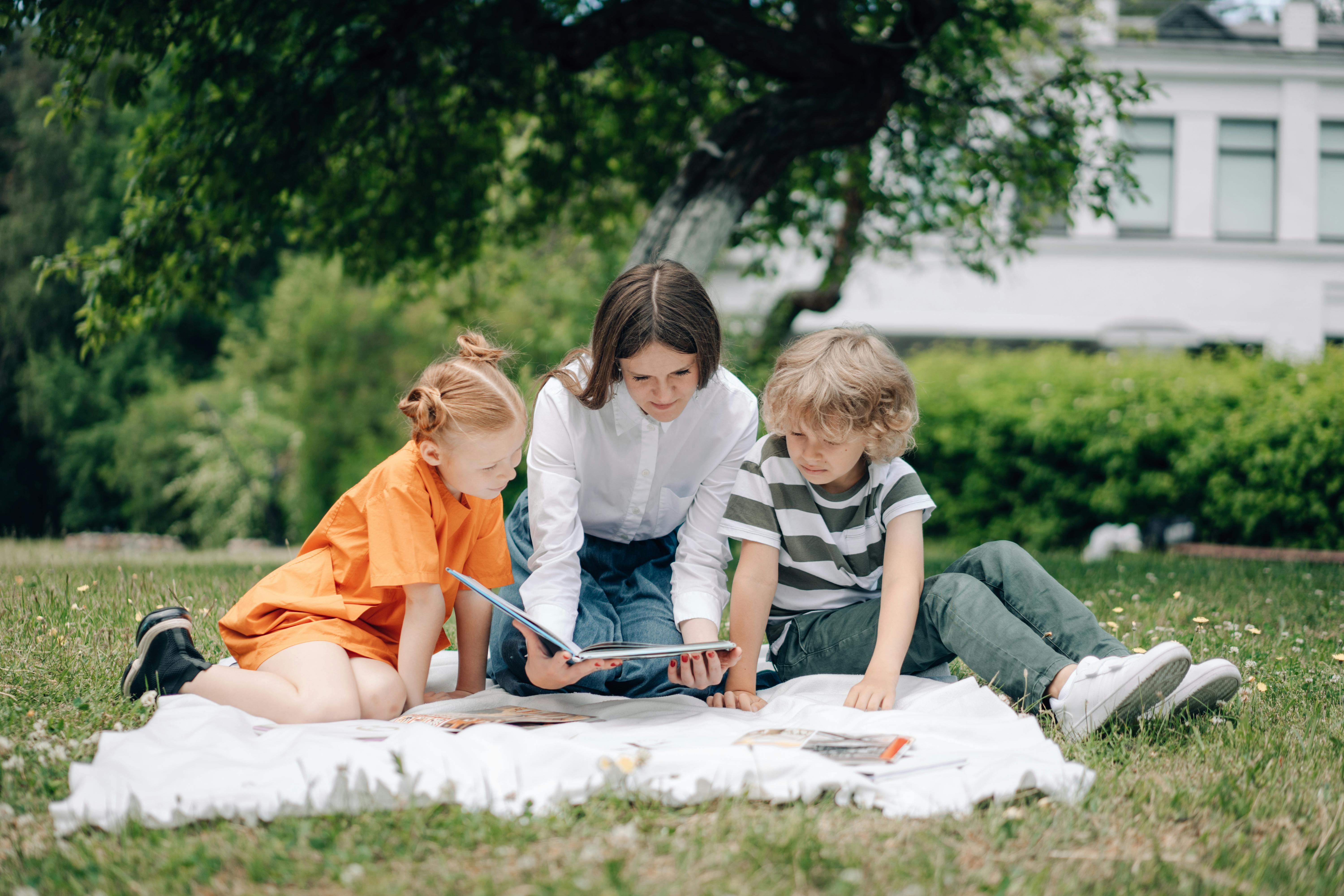As a mom who has a daughter and a son four years apart, and when we were fostering, had children even more spread out: I know that it can sometimes be a challenge to do family storytime with a spread of ages and still make everyone happy. I’m here to tell you that it’s possible and wonderful!
When my toddler wanted “The Little Blue Truck” for the hundredth time while my older child begged for another chapter of “Charlotte’s Web,” I knew I needed a better strategy for family reading time. After years of teaching mixed-age groups and managing my own family’s reading routine, I’ve discovered that reading to multiple ages doesn’t have to be chaotic – it can actually be magical!
For more detailed book recommendations for each age group, check out my Best Family Read-Aloud Books: Complete Guide by Age. And for creating special reading moments with your family, don’t miss my How to Make Family Reading Time Special: Ultimate Guide.
Why Reading Together Matters
When we sit around the dinner table and one of my children starts talking about what happened in Harry Potter, and we all start discussing the finer points of the Triwizard Tournament together, I smile. It’s easy for each family member to have their own hobbies, interests, and different friends at school, but family story time gives us a shared reference point for laughing, talking, and living life connected to each other.
Benefits of reading together:
- Builds family connections
- Helps younger children learn from older ones
- Develops listening skills
- Creates shared experiences
- Expands everyone’s vocabulary
Choosing Books That Work for Everyone
A good book should be able to be enjoyed by the whole family. One of my favorite quotes about children’s books is from C.S. Lewis:
A children’s story that can only be enjoyed by children is not a good children’s story in the slightest.
C.S. Lewis
Look for books that:
- Have layers of meaning
- Include pictures and text
- Appeal to different levels
- Encourage discussion
Great “bridging” books include:
- Picture books with complex themes
- Illustrated chapter books
- Interactive non-fiction
- Poetry collections
- Wordless picture books
Creating an Inclusive Reading Environment
Tips for comfortable group reading:
- Arrange seating so everyone can see
- Provide quiet activities for busy hands
- Create different listening spots
- Keep relevant books accessible
- Make space for movement
Managing Different Attention Spans
I started reading chapter books as part of our family storytime when my daughter, who is older, was ready for them. My son was still too young to really get into the chapter books yet, but he still enjoyed being with the family and having a snack and playing quietly with his cars or scribbling on a paper while I read.
Practical strategies:
- Each child can pick a story for their age (a board book, a picture book, a chapter book, etc.)
- Start with younger children’s books
- Move to longer stories as little ones tire
- Allow quiet play during longer reads
- If attention spans wane, you can stop.
Engaging Multiple Ages
Activities that work for everyone:
- Character voices (let older kids help)
- Story predictions: ask what they think will happen next
- Picture walks: look through the pictures of a book before reading it to build interest
- Acting out scenes: older kids might like to act a scene out for younger children
- Making sound effects: any fun sounds can help younger kids engage more
The Power of Taking Turns
How to balance everyone’s needs:
- Alternate book choices
- Create a fair selection system
- Mix short and long reads
- Share reading responsibilities
- Honor each child’s preferences
Special Roles for Different Ages
Kids of different ages can get more involved in family reading time when they each can contribute on their own level.
Older children can:
- Help read simpler books
- Explain difficult words
- Choose bonus activities
- Lead discussions
- Create related games
Younger children can:
- Turn pages
- Find specific items in pictures
- Make sound effects
- Act out simple parts
- Choose between limited options
Making It Work Throughout the Day
Books can be a part of your day in smaller chunks if that’s how it works for your routine! You can try different books at different times of the day!
- Morning: Short, energetic stories
- Afternoon: Interactive books
- Bedtime: Calming stories
- Meal times: Simple poems
- Travel: Audio books
Problem-Solving Common Challenges
When attention spans vary:
- Use bookmark breaks
- Provide quiet activities
- Create listening games
- Take movement breaks
- Mix up reading styles
When interests conflict:
- Each child gets a chance to pick (whether each gets a book, or each gets a day to pick)
- Find common themes
- Create themed reading days
- Use topic rotation
- Make it game-like
- Connect to their interests
Building Your Library
Tips for a multi-age collection:
- Include various reading levels
- Mix genres and styles
- Rotate books seasonally
- Keep favorites accessible
- Add interactive elements
- Face-out some books to grab children’s interest
Special Activities for Mixed Ages
Fun ideas to try:
- Create story boxes
- Make reading passports
- Start a family book club
- Design story maps
- Record family readings
Remember This!
Success with multi-age reading looks different for every family. The key is to:
- Be flexible
- Keep it positive
- Celebrate participation
- Honor preferences
- Create traditions
Want more specific book recommendations for your children’s ages? Check out my complete guide to Best Family Read-Aloud Books by Age. And for ideas on making reading time extra special, visit my How to Make Family Reading Time Special guide.
Have you found creative ways to read to children of different ages? Share your tips in the comments below!




0 Comments